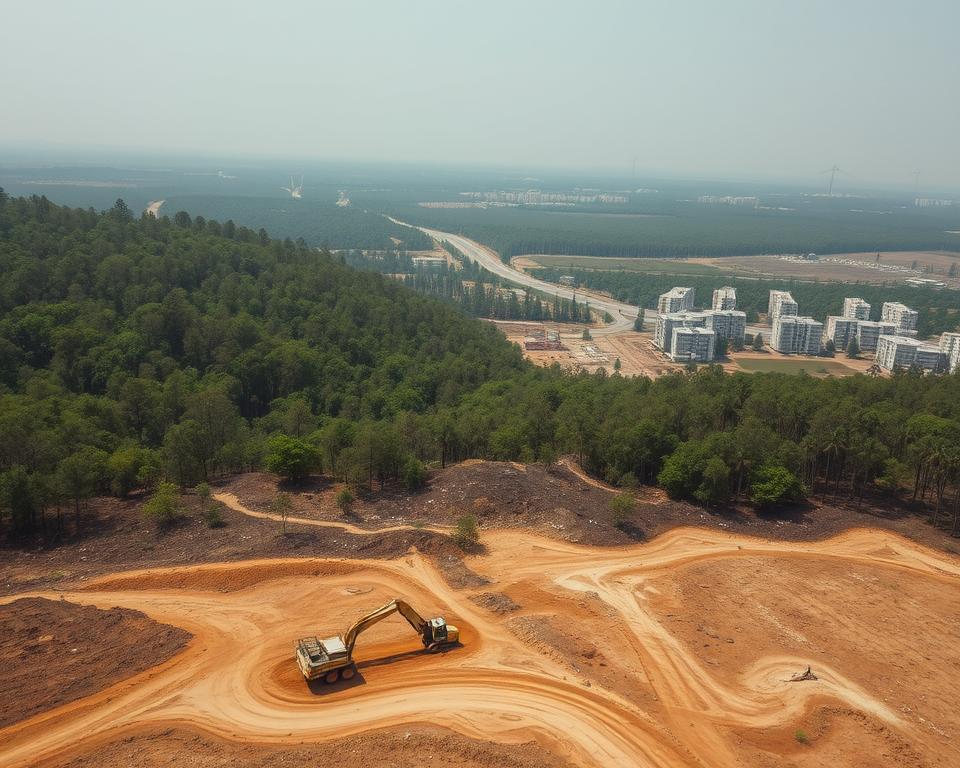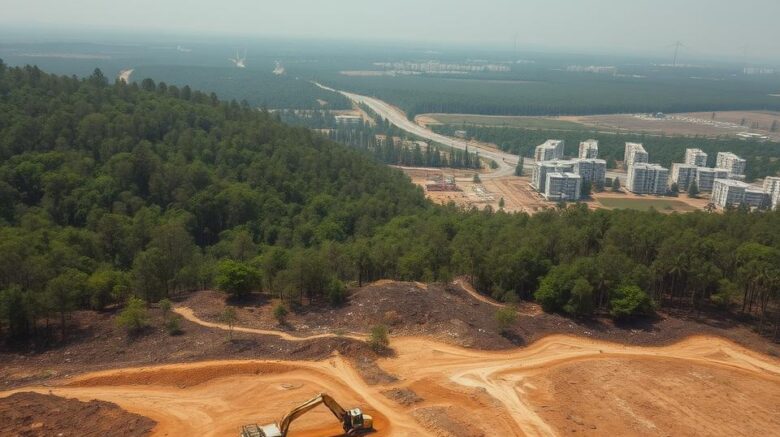Land Clearing in Proximity to Water Sources: Best Methods
It might interest you to know that nearly roughly seven in ten of the global fresh water supplies suffer threats from agricultural drainage and Land Clearing? Such a startling statistic underscores the critical necessity for responsible land management, essential during water source Land Clearing. Guaranteeing ecological accountability is vital for upholding ecosystem equilibrium and protecting water quality and faunal habitats. With increasing resource demands from communities, embracing sustainable land management practices is indispensable. It helps achieve project goals while preventing soil erosion and reducing pollution risks in aquatic ecosystems – land clearing services.
Key Conclusions
- Sustainable land management is essential for protecting water quality.
- Embracing best practices prevents soil erosion and destruction of habitats.
- Recognizing ecological impacts is vital for responsible Land Clearing.
- Proper planning enhances project success while safeguarding ecosystems.
- Applying successful techniques encourages biodiversity in aquatic landscapes.
Grasping the Significance of Sustainable Land Clearing
Land Clearing involves more than simply uprooting vegetation. It has ecological effects of Land Clearing that can affect adjacent zones, particularly aquatic ones. Conventional approaches typically lead to soil erosion, habitat disruption, and water contamination. Understanding these effects is crucial to adopting improved land management.
Ecological Effects of Conventional Land Clearing
Standard Land Clearing methods can cause many environmental issues. Loss of vegetation results in soil erosion, soil degradation, and sediment runoff into aquatic systems. Such runoff contaminates water bodies, harming aquatic ecosystems. This process puts local wildlife at risk and disturbs ecosystem balance.
Sustainable Alternatives for Land Management
Embracing sustainable land management practices addresses issues caused by conventional clearing. Selective clearing, where specific plants are removed, preserves ecosystem balance. Applying erosion control tactics, including cover crops, fortifies soils and maintains water quality. Emphasizing indigenous vegetation bolsters wildlife and fosters ecological well-being.
Essential Best Practices for Land Clearing
Successful clearing projects hinge on a solid understanding of ecological factors. Evaluating environmental aims is key for ensuring effective, sustainable clearing. With defined objectives, landowners can make choices that align environmental protection with development priorities.

Evaluating Your Environmental Objectives
Before starting any clearing project, it’s essential to assess environmental goals. This process includes analyzing the ecosystem and potential clearing effects on wildlife, soil, and water. Defining personal objectives aids in crafting strategies to safeguard local habitats and watersheds.
Selecting the Optimal Time for Clearing
Choosing the right time for Land Clearing is essential. Clearing during winter or early spring—when soils are frozen—minimizes disturbance and erosion. Understanding avoidance periods results in healthier landscapes and diminished environmental impact.
Understanding Local Clearing Regulations
Adhering to local Land Clearing rules is essential for project success. Knowing permit prerequisites helps prevent legal troubles or penalties. It’s wise to check local ordinances, even near protected areas, to avoid environmental disasters from unapproved clearing.
Land Clearing By Water Sources: Top Techniques
Clearing strategies around aquatic sources emphasize safeguarding sensitive zones and preserving ecological equilibrium. A thorough approach involves identifying regions that require special care and implementing appropriate erosion control methods. These measures are essential for safeguarding biodiversity and upholding water purity.
Identifying Sensitive Areas that Need Protection
Before clearing begins, identifying sensitive areas, such as wetlands and riparian buffers, is vital. These unique ecological zones play a vital role in filtering pollutants and providing habitat for various species. By properly identifying these areas, land managers can devise strategies for protecting sensitive areas during and after the clearing process.
Implementing Erosion Control Measures
Once sensitive areas have been identified, effective erosion control methods must be employed to minimize sediment runoff into adjacent water bodies. Methods like silt fences, vegetative buffers, and cover cropping are key to preserving water purity. Emphasizing sustainable Land Clearing practices in combination with these erosion control measures fosters a healthier ecosystem around water resources. Such practices support environmental health and community well-being.
Mechanical vs. Manual Land Clearing Methods
Selecting mechanical or manual clearing is key. Each has its own set of advantages and disadvantages, affecting the environment and the clearing process’s efficiency. Grasping these distinctions aids landowners in choosing strategies that suit their land management objectives.
Mechanical Clearing: Benefits and Drawbacks
Mechanical Land Clearing employs heavy machinery to swiftly remove trees, shrubs, and debris. It speeds project timelines and reduces manual labor requirements. However, heavy equipment may disturb soils, cause compaction, and harm ecosystems.
- Benefits: Quick removal of extensive regions.
- Lower manual labor expenses.
- Ability to handle tough terrain.
- Cons: Increased environmental impact.
- Potential for soil erosion.
- Risk of habitat destruction.
Benefits of Manual and Selective Clearing
Manual, selective clearing prioritizes ecological preservation. They use skilled labor for targeted removal, minimizing soil disturbance and preserving plant species. This approach suits projects where biodiversity and ecosystem health are priorities.
- Benefits: Conservation of indigenous plants.
- Lowered soil disturbance and erosion rates.
- Improved wildlife habitat preservation.
Wetland Land Clearing Practices
Wetlands are unique zones essential for ecological equilibrium. They cleanse water, moderate floods, and support various plant and animal species. Grasping wetland ecology is critical for responsible clearing. The aim is to reduce disturbances and protect these crucial aquatic zones.
Understanding Wetland Ecosystems
Wetlands feature specific hydrologic conditions, soils, and flora. They act as interfaces between land and water, sheltering multiple species. These ecosystems are essential for water quality regulation, providing natural filtration processes that remove pollutants. Preserving their integrity contributes to overall biodiversity and ecological resilience.
Responsible Wetland Clearing Methods
Responsible wetland clearing requires careful planning and execution. Techniques that promote ecological sustainability can mitigate the negative impacts of Land Clearing. Commonly used strategies include:
- Staging Operations: Conduct clearing in phases to minimize ecological disruption, allowing time for wildlife to adapt.
- Targeted Clearing: Remove only specific vegetation types, preserving critical species for habitat stability.
- Regrowth Practices: Introduce practices that encourage natural vegetation regrowth after clearing, maintaining ecosystem functions.
- Establishing Buffer Areas: Establish buffer areas around sensitive wetland sections to protect aquatic habitats from disturbances.
Implementing these techniques confirms that wetland clearing upholds ecosystem services and curbs habitat destruction.
Riparian Reserve Protection Strategies
Riparian reserves are vital for maintaining healthy aquatic ecosystems. Situated along watercourses, they serve as natural protective buffers. They safeguard water quality and enhance biodiversity. With best practices, managers avoid erosion, conserve wildlife habitats, and uphold waterway ecology.
Riparian Buffer Functions
Riparian buffers are key to supporting aquatic ecosystems. They filter pollutants, stabilize shorelines, and provide habitats for various species. They serve as barriers that lessen human impact on aquatic systems. Protecting riparian areas enhances water quality, supports fish populations, and strengthens ecosystem resilience.
Essential Riparian Zone Maintenance Practices
To keep riparian reserves effective, several best practices are essential:
- Avoid construction within buffer strips to minimize disturbance.
- Use native vegetation to stabilize banks and prevent erosion.
- Establish a diverse plant community to enhance habitat complexity and support wildlife.
- Manage invasive species to protect native plants and maintain ecosystem stability.
- Regularly assess soil health and water quality to guide management efforts.
Significance of Aquatic Land Clearing Strategies
Aquatic land clearing strategies are vital for ecological balance and healthy water systems. Managing water quality effectively during clearing minimizes pollution risks and supports sustainability. Such methods curb sediment runoff and bolster aquatic ecosystem health.
Water Quality and Sediment Management Tactics
Effective water quality management starts with assessing local water bodies. Clearing adjacent to water systems must avoid sediment deposits that damage water quality and aquatic organisms. Strategies include:
- Establishing buffer zones to filter pollutants
- Using sediment traps and barriers to minimize runoff
- Selecting clearing times to coincide with low water levels
Such measures preserve water quality and uphold ecosystem integrity. Retained vegetation helps control sediments and cycle nutrients, resulting in healthier water systems.
Aquatic Biodiversity Protection
Maintaining biodiversity in aquatic landscapes is key for resilient ecosystems. Aquatic land clearing should preserve native species, which are vital for these habitats. Practices to enhance biodiversity include:
- Conserving critical habitats during clearing processes
- Implementing phased clearing to allow wildlife adaptation
- Restoring natural vegetation post-clearing to enhance habitat
Embracing these tactics enables managers to nurture biodiversity in water-adjacent areas. These actions yield stronger, more adaptable ecosystems. Such measures defend water quality and encourage sustainable land management.
Stream Bank and Riverbank Clearing Considerations
Stream bank clearing comes with its own set of challenges, needing a focus on environmental impacts and regulatory compliance. The process must honor riverbank requirements to protect water source ecology. Issues like erosion, habitat disruption, and water quality decline require strategic solutions during clearing.
Obstacles in Stream Bank Clearing
Stream bank clearing faces numerous hurdles. Erosion is a major concern, causing soil loss and water quality deterioration. Disturbing habitats affects wildlife reliant on riparian areas. Without plants, stormwater runoff surges, depositing sediments in watercourses. Such problems underscore the importance of managing stream banks effectively.
Erosion Mitigation and Flora Support
Addressing erosion is critical during stream bank clearing. Using indigenous vegetation fortifies banks. Roots curtail erosion, supporting a resilient environment for adjacent flora and fauna. Regular assessments during clearing ensure methods are effective, keeping riverbank considerations central to environmental care. Robust vegetation aids land management and preserves ecological integrity.
The Final Word
Applying optimal practices for clearing near water sources is vital for ecosystem health. Stakeholders need to prioritize sustainable land management. This method accomplishes objectives and defends natural resources. Careful planning and execution ensure Land Clearing operations safeguard aquatic ecosystems and preserve biodiversity.
Identifying sensitive areas and using erosion control measures are key steps. Using mechanical and manual methods enables landowners and contractors to practice responsible land management. Sustainable practices foster harmony between development and nature. This ensures water sources and adjacent landscapes remain vibrant and resilient.
Sustainable land management is a shared duty. Each step in Land Clearing affects watershed integrity. By integrating environmentally responsible practices, we can create a future where agriculture and the environment coexist harmoniously.
